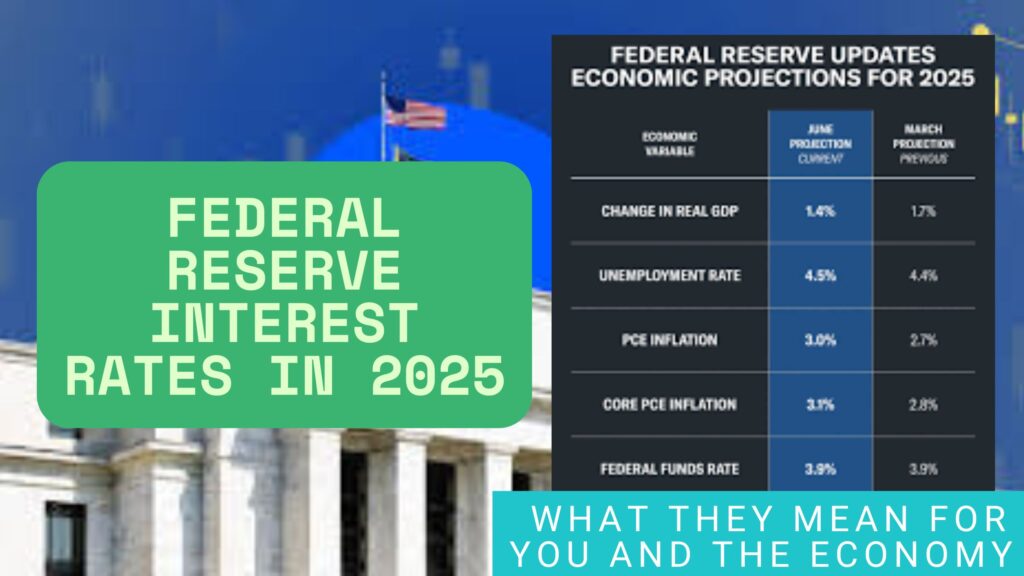The Federal Reserve’s interest rate decisions have a direct impact on your wallet, loans, credit cards, mortgages, and the broader U.S. economy. Whether you’re a homeowner, small business owner, investor, or just someone tracking inflation, understanding the Federal Reserve interest rate trends in 2025 is more important than ever. (Federal Reserve Interest Rates in 2025)

In this article, we break down:
- What the Fed interest rate is
- Why it changes
- What’s happening in 2025
- How it affects your money
- What to expect in the second half of 2025
🔍 What Are Federal Reserve Interest Rates?
The Federal Reserve interest rate most commonly discussed is the federal funds rate—the rate banks charge each other for overnight loans. But it’s more than just a number for financial institutions. It sets the tone for the cost of borrowing across the country.
Quick Terms to Know:
- Federal Funds Rate: The target range set by the Federal Reserve.
- Prime Rate: The rate banks charge their best customers, often tied to the federal funds rate.
- Mortgage Rates, Auto Loans, Credit Cards: All influenced by the Fed’s rate moves.
📈 Why Does the Fed Change Interest Rates?
The Federal Reserve adjusts rates based on two primary goals:
- Control Inflation (keep it around 2%)
- Maintain Full Employment (strong job growth, low unemployment)
When the economy is overheating and inflation is rising, the Fed may raise rates to cool spending. When the economy is slowing or facing recession, the Fed may cut rates to stimulate borrowing and investment.
📅 Federal Reserve Interest Rate Trends in 2025
📊 The Current Federal Funds Rate (June 2025)
As of mid-2025, the federal funds rate stands at 4.75%–5.00%, a slight reduction from 2024’s peak of 5.25%. This is the first sign of easing after two years of aggressive rate hikes aimed at curbing post-COVID inflation.
Reddit Stock Price Prediction 2025
How to Start Mutual Fund Investment in the USA
Lockheed Martin (LMT) Stock Price Today & P/E Ratio
📰 Key Milestones:
- 2022–2023: Fed raised rates rapidly to fight record-high inflation.
- 2024: Rates peaked, inflation cooled slightly, but recession fears grew.
- 2025: Fed started minor cuts amid moderate inflation and slowing job growth.
💼 Why the Fed Started Cutting Rates in 2025
By early 2025, the U.S. economy showed signs of slowing growth:
- Consumer spending dropped
- Job creation plateaued
- Housing market cooled
- Small business confidence fell
At the same time, inflation—while still above the Fed’s 2% target—was no longer out of control. The Consumer Price Index (CPI) hovered around 3.2%, down from over 7% in 2022.
In response, the Fed initiated a “soft pivot”—a strategy of gradual rate cuts designed to avoid a recession while still keeping inflation in check.
💳 How Fed Interest Rates Affect You in 2025
🏡 1. Mortgage Rates
Mortgage rates closely follow the federal funds rate. In 2025:
- 30-year fixed mortgage rates dropped slightly to around 6.25%–6.75%
- Refinancing became more appealing again for homeowners
- Home prices stabilized after several years of volatility
If you’re looking to buy or refinance a home, the Fed’s moves are directly tied to your long-term costs.
🚗 2. Auto Loans
Auto loan rates fell slightly, but remained relatively high compared to pre-pandemic levels.
- Average new car loan: 7.5%–8.2%
- Used car loan: 8.5%–9.5%
This means car buyers still need strong credit to avoid expensive financing.
💸 3. Credit Cards
Credit card interest rates remain extremely high, averaging over 20% APR. That’s because these rates respond quickly to the Fed’s increases, but slow to fall when rates are cut.
If you carry a balance, now’s the time to consider balance transfer offers or paying off debt aggressively.
🏦 4. Savings Accounts & CDs
On the bright side, savers are still enjoying higher yields:
- High-yield savings: 4.25%–5.00%
- CDs (1-year): 4.75%–5.50%
However, banks have started slowly trimming returns, so locking in a CD may be wise in a falling rate environment.
📉 Impact on the Broader Economy
🧱 Housing Market
The Fed’s rate decisions continue to shape the housing market:
- Slightly lower rates have reignited buyer interest in affordable markets.
- High construction costs still limit supply.
- Home equity remains high, but price growth is slowing.
🏭 Job Market
While unemployment remains low (~4.1%), wage growth has stalled, and job openings have shrunk. The Fed’s rate policies aim to balance inflation without triggering job losses—but the risk of a downturn still looms.
💹 Stock Market
Markets generally cheered the Fed’s softer stance in early 2025:
- Tech and growth stocks surged on lower borrowing costs.
- Bank stocks lagged due to lower lending profitability.
- Volatility remains high amid economic uncertainty.
🔮 What to Expect for the Rest of 2025
Fed’s Likely Path:
Most analysts predict two more rate cuts before the end of the year, potentially bringing the federal funds rate to 4.00%–4.25% by December 2025.
This depends on:
- Continued decline in inflation
- No major economic shocks (e.g., energy crisis, geopolitical conflict)
- Stability in job and housing markets
What It Means for You:
| If you are… | Here’s what to watch |
|---|---|
| Homebuyer | Rates may fall more—stay alert for better mortgage deals |
| Borrower with debt | Now’s the time to pay down high-interest credit cards |
| Saver | Consider locking in high CD rates before they drop |
| Investor | Stocks may benefit from looser Fed policy—but stay diversified |
| Business owner | Lower rates could ease borrowing costs by late 2025 |
🗣 What the Fed Is Saying
Federal Reserve Chair Jerome Powell has emphasized a “data-driven” approach:
“We remain committed to bringing inflation back to 2%, but we’re also mindful of the risks of overtightening. If the data supports further easing, we will act accordingly.”
This cautious, flexible language suggests the Fed will not rush into aggressive cuts—but will act if the economy shows signs of stress.
🧠 Final Thoughts: Navigating the Fed in 2025
In 2025, the Federal Reserve’s rate strategy is at a turning point. After years of aggressive hikes, the central bank is now shifting toward controlled easing to maintain stability without fueling inflation.
For consumers, this means opportunities and risks:
- Borrowing may become slightly cheaper
- Savings rates could decline
- Markets may recover cautiously
- The economy still walks a tightrope between inflation control and growth
Stay tuned to Fed announcements, monitor inflation and jobs data, and make financial decisions that align with your long-term goals—not just short-term rate trends.
❓ FAQs About Federal Reserve Interest Rates
🔸 What is the federal funds rate right now?
As of June 2025, the federal funds rate is 4.75%–5.00%.
🔸 How does the Fed affect my mortgage or car loan?
When the Fed raises or lowers rates, borrowing costs adjust accordingly. Lower Fed rates usually mean lower mortgage and auto loan interest over time.
🔸 Will the Fed keep cutting rates in 2025?
Most experts believe the Fed will make 1–2 small rate cuts by the end of the year, depending on inflation and job growth.
🔸 Are interest rates good or bad for the economy?
It depends on timing. High rates help fight inflation, but can slow economic growth. Low rates stimulate the economy, but can fuel inflation if left too low too long.
🔸 Should I refinance my mortgage now?
If your rate is above 7% and you plan to stay in your home, refinancing may save you money—especially if the Fed cuts rates further in 2025.

